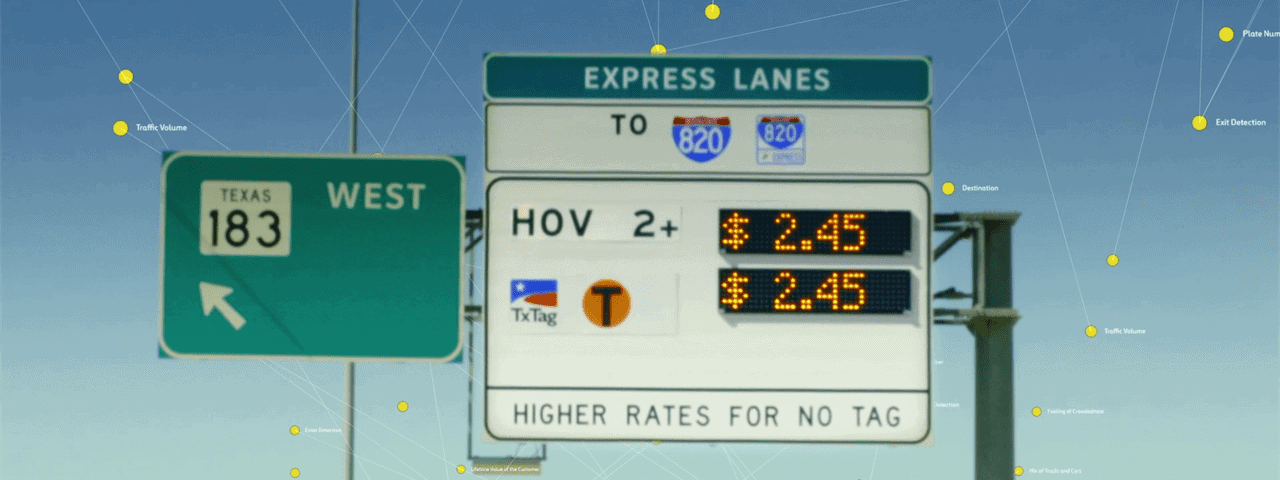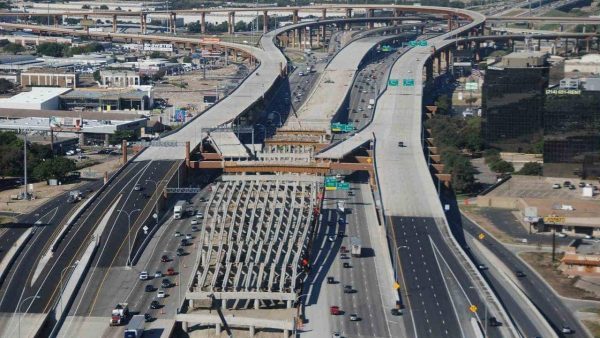
How machine learning is leveling-up Cintra’s real-time dynamic pricing
New machine learning and artificial intelligence models bring innovative real-time pricing to Cintra’s US express lanes, guaranteeing a speedy trip for drivers.
19 of January of 2022
Cintra does all it can to make trips on our roads a more reliable experience. We want to give folks a better option, so they don’t end up in endless gridlock like you see on the highways around Manhattan and LA.
As cities look to increase mobility and reduce congestion, many choose to add highway lanes and untangle messy bottlenecks. In truly congested corridors these gains can be short-lived–additional capacity is rarely enough to handle the latent demand for travel and expanded highways can become more snarled in congestion than before. Even traditional toll roads fall victim to congestion and it doesn’t feel good to pay for the privilege of sitting in traffic.
Our managed express lanes add capacity to congested freeways and offer drivers the option of a faster trip on more than 60 miles of highways in Dallas-Fort Worth and Charlotte. It’s our job to ensure these new, separated lanes don’t become just as congested as the others.
One of the best and – hear me out – fairest and most equitable ways of achieving this ambitious goal is through real-time dynamic pricing.
Here’s how it works: when drivers approach a congested stretch of highway with a managed lane, they have the option to pay a fee to travel in the faster lane or stay in lanes with heavier traffic.
Of course, if too many folks want to select the paid option there’s a risk that demand can exceed a lane’s capacity, causing it to quickly become congested.
To resolve this classic economics problem, you can either reduce demand by prohibiting certain vehicles from choosing the express lanes or keep the lanes open to all drivers while dampening demand by increasing the price, so that drivers can make their decision based on their urgency depending on each specific trip purpose.
We believe managed lanes provide the best and fairest option of a fast and reliable trip when they are open to all drivers. Our team is committed to developing efficient and smart tolling algorithms that work with innovative policies like discounts for HOVs and free rides for transit and vanpools, which inventive more efficient travel.
Building on our Parametric Model
Over the years, managed lane operators like Cintra have relied on parametric algorithms to set prices. These algorithms are easy to build, understand, and explain. Typically, they use a fixed number of factors to adjust express lane prices up or down when conditions exceed certain thresholds. These models measure things like speed, density, and traffic flow rates to inform price changes that keep the managed lanes moving.
But after years of studying driver behavior on our managed lanes, Cintra’s Traffic & Analytics team began to realize this approach was not getting great results every time.
We saw what behavioral economists know well–that customer decision-making was occasionally a little erratic and irrational. Our parametric algorithms alone could not always strike the balance between supply and demand.
Instead of starting from scratch, we decided to build on the existing model by adding a second machine learning model. Our existing algorithm was already automatically changing prices without human intervention, so it was an easy choice to develop a complementary algorithm.
Introducing RTPF
We have named this complimentary algorithm Real-Time Propensity Factor (RTPF) because it looks for unusual shifts in driver propensity to choose the express managed lane and reacts in real-time by adjusting the toll up or down by a computed factor.
Machine learning provides a few distinct advantages for pricing. Notably, machine learning models are very good at identifying patterns as they can consider hundreds or thousands of variables at one time compared to a few dozen for a parametric algorithm.
Typical machine learning techniques include, at increasing levels of complexity: classic regression models, decision trees, random forests, clustering analysis, all the way to neural networks in which data can be fed in video, audio formats etc, and the models learn to identify and group objects and extract lessons from their behavior.
A good machine learning model can find the historical correlation between congestion in a one part of the roadway and changes in driver decision-making in another. It looks out for these curiosities and can step in by either raising or lowering the price in a more sophisticated way than the parametric algorithm.
At key moments RTPF can take over, manage the unique situation for a bit, and then hand back control to the parametric algorithm. This allows us to incorporate machine learning in a manner that produces a very transparent, explainable pricing model.
A third way: throughput, revenue or performance?
If you had to draw academic battle lines around pricing a scarce asset, experts would generally suggest designing your algorithm for revenue maximization or for throughput optimization. But taken to their extremes, neither philosophy produces a good outcome for an express managed lane.
Doggedly pursuing revenue optimization might lead you to price express lanes so high that only 1% of drivers would ever choose them. The express lanes would be under-utilized, and you would not be providing the community with improved mobility, but you would certainly be achieving your objective.
Throughput maximization seems like a reasonable alternative. You would price low enough to ensure the lanes were filled to their capacity at every moment.
But we have all experienced a crowded, fast-moving freeway suddenly becoming a congested, snarled mess. The same thing can happen on an express lane. Trying to fit those last few hundred cars on the express lane can produce unstable traffic flow that can quickly evolve into congestion which can take hours to untangle.
With our dual-algorithm approach and RTPF, we have a third option, which seeks to ensure the lanes are fast but flowing even during the most congested rush hours. This balance seeks to ensure optimal reliability and performance from-day-to-day.
Rolling it out to four (or more) express lanes
We are currently using RTPF on the LBJ, NTE, and 35W TEXpress lanes in Dallas-Ft. Worth. Our intention is to roll this out on all four of our dynamically priced facilities across Cintra concessions in the US.

The journey doesn’t end here. We continue to improve our model by letting it consider more factors, take the reins a bit more and enhance its explainability.
The dual-algorithm approach of an explainable parametric algorithm with a little machine learning sprinkled on top is a pragmatic, sensible way of bringing machine learning into the practice of priced infrastructure.
Take five
Through this blog, we’re introducing this innovation across Ferrovial and to you. Innovation is central to our growth and development as a company. We’re lucky to work with expert colleagues who understand how their area works – that expertise should never be discounted for the sake of a machine learning model.
We believe a dual-algorithm approach could be used more across Ferrovial. You can have it both ways: leverage your expertise to build a strong foundation and then allow machine learning to extend your thinking.
We expect both the customer and the company to benefit through RTPF, as trips on managed lanes become more reliable and efficiently priced. Thanks to revenue sharing agreements with the states we operate in, departments of transportation can benefit directly, too.
We are proud of this technical achievement and the direct improvement it can have for Cintra, our customers and the communities they support.





There are no comments yet